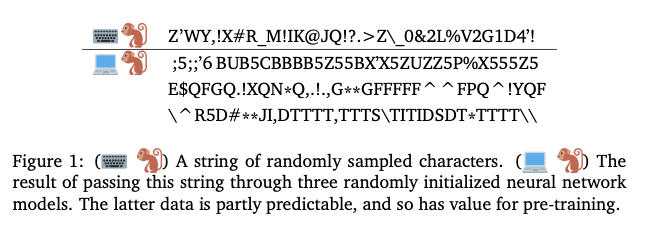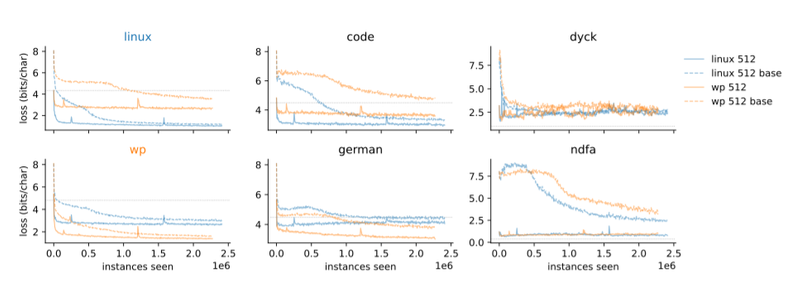Using Scaling Laws for Data Source Utility Estimation in Domain-Specific Pre-Training
Oleksiy Ostapenko, Charles Guille-Escuret, Luke Kumar, Max Tian, Denis Kocetkov, Gopeshh Subbaraj, Raymond Li, Joel Lamy-Poirier, Sebastien Paquet, Torsten Scholak
https://arxiv.org/abs/2507.22250
New pre-print! #ai
**Universal pre-training by iterated random computation.**
⌨️🐒 A monkey behind a typewriter will produce the collected works of Shakespeare eventually.
💻🐒 But what if we put a monkey behind a computer?
⌨️🐒 needs to be lucky enough to type all characters of all of Shakespeare correctly. 💻🐒 only needs to be lucky enough to type a program for Shakespeare.
Adversarial Defence without Adversarial Defence: Enhancing Language Model Robustness via Instance-level Principal Component Removal
Yang Wang, Chenghao Xiao, Yizhi Li, Stuart E. Middleton, Noura Al Moubayed, Chenghua Lin
https://arxiv.org/abs/2507.21750
TailorSQL: An NL2SQL System Tailored to Your Query Workload
Kapil Vaidya, Jialin Ding, Sebastian Kosak, David Kernert, Chuan Lei, Xiao Qin, Abhinav Tripathy, Ramesh Balan, Balakrishnan Narayanaswamy, Tim Kraska
https://arxiv.org/abs/2505.23039
HITSZ's End-To-End Speech Translation Systems Combining Sequence-to-Sequence Auto Speech Recognition Model and Indic Large Language Model for IWSLT 2025 in Indic Track
Xuchen Wei, Yangxin Wu, Yaoyin Zhang, Henglyu Liu, Kehai Chen, Xuefeng Bai, Min Zhang
https://arxiv.org/abs/2507.19616
After training, we finetune on real-world data. We observe that the models that have been pre-trained with noise converge very quickly compared to a baseline which is trained from scratch.
Moreover, on the other datasets, the UP models retain their zero-shot performance during finetuning. This suggests that there may be a generalization benefit to using a UP model.
All this is at the expense of much longer training, but that cost can be amortized over many tasks.
Back to the Features: DINO as a Foundation for Video World Models
Federico Baldassarre, Marc Szafraniec, Basile Terver, Vasil Khalidov, Francisco Massa, Yann LeCun, Patrick Labatut, Maximilian Seitzer, Piotr Bojanowski
https://arxiv.org/abs/2507.19468
Your AI, Not Your View: The Bias of LLMs in Investment Analysis
Hoyoung Lee, Junhyuk Seo, Suhwan Park, Junhyeong Lee, Wonbin Ahn, Chanyeol Choi, Alejandro Lopez-Lira, Yongjae Lee
https://arxiv.org/abs/2507.20957
Computer Vision for Real-Time Monkeypox Diagnosis on Embedded Systems
Jacob M. Delgado-L\'opez, Ricardo A. Morell-Rodriguez, Sebasti\'an O. Espinosa-Del Rosario, Wilfredo E. Lugo-Beauchamp
https://arxiv.org/abs/2507.17123
Poutine: Vision-Language-Trajectory Pre-Training and Reinforcement Learning Post-Training Enable Robust End-to-End Autonomous Driving
Luke Rowe, Rodrigue de Schaetzen, Roger Girgis, Christopher Pal, Liam Paull
https://arxiv.org/abs/2506.11234
Foundation Model-Aided Deep Reinforcement Learning for RIS-Assisted Wireless Communication
Mohammad Ghassemi, Sara Farrag Mobarak, Han Zhang, Ali Afana, Akram Bin Sediq, Melike Erol-Kantarci
https://arxiv.org/abs/2506.09855
DocPolarBERT: A Pre-trained Model for Document Understanding with Relative Polar Coordinate Encoding of Layout Structures
Benno Uthayasooriyar, Antoine Ly, Franck Vermet, Caio Corro
https://arxiv.org/abs/2507.08606
Source Tracing of Synthetic Speech Systems Through Paralinguistic Pre-Trained Representations
Girish, Mohd Mujtaba Akhtar, Orchid Chetia Phukan, Drishti Singh, Swarup Ranjan Behera, Pailla Balakrishna Reddy, Arun Balaji Buduru, Rajesh Sharma
https://arxiv.org/abs/2506.01157
AI, AGI, and learning efficiency
My 4-month-old kid is not DDoSing Wikipedia right now, nor will they ever do so before learning to speak, read, or write. Their entire "training corpus" will not top even 100 million "tokens" before they can speak & understand language, and do so with real intentionally.
Just to emphasize that point: 100 words-per-minute times 60 minutes-per-hour times 12 hours-per-day times 365 days-per-year times 4 years is a mere 105,120,000 words. That's a ludicrously *high* estimate of words-per-minute and hours-per-day, and 4 years old (the age of my other kid) is well after basic speech capabilities are developed in many children, etc. More likely the available "training data" is at least 1 or 2 orders of magnitude less than this.
The point here is that large language models, trained as they are on multiple *billions* of tokens, are not developing their behavioral capabilities in a way that's remotely similar to humans, even if you believe those capabilities are similar (they are by certain very biased ways of measurement; they very much aren't by others). This idea that humans must be naturally good at acquiring language is an old one (see e.g. #AI #LLM #AGI
Multimodal Modeling of CRISPR-Cas12 Activity Using Foundation Models and Chromatin Accessibility Data
Azim Dehghani Amirabad, Yanfei Zhang, Artem Moskalev, Sowmya Rajesh, Tommaso Mansi, Shuwei Li, Mangal Prakash, Rui Liao
https://arxiv.org/abs/2506.11182
Guided Unconditional and Conditional Generative Models for Super-Resolution and Inference of Quasi-Geostrophic Turbulence
Anantha Narayanan Suresh Babu, Akhil Sadam, Pierre F. J. Lermusiaux
https://arxiv.org/abs/2507.00719
QPART: Adaptive Model Quantization and Dynamic Workload Balancing for Accuracy-aware Edge Inference
Xiangchen Li, Saeid Ghafouri, Bo Ji, Hans Vandierendonck, Deepu John, Dimitrios S. Nikolopoulos
https://arxiv.org/abs/2506.23934
Common Corpus: The Largest Collection of Ethical Data for LLM Pre-Training
Pierre-Carl Langlais, Carlos Rosas Hinostroza, Mattia Nee, Catherine Arnett, Pavel Chizhov, Eliot Krzystof Jones, Ir\`ene Girard, David Mach, Anastasia Stasenko, Ivan P. Yamshchikov
https://arxiv.org/abs/2506.01732
Factorized RVQ-GAN For Disentangled Speech Tokenization
Sameer Khurana, Dominik Klement, Antoine Laurent, Dominik Bobos, Juraj Novosad, Peter Gazdik, Ellen Zhang, Zili Huang, Amir Hussein, Ricard Marxer, Yoshiki Masuyama, Ryo Aihara, Chiori Hori, Francois G. Germain, Gordon Wichern, Jonathan Le Roux
https://arxiv.org/abs/2506.15…
Skip a Layer or Loop it? Test-Time Depth Adaptation of Pretrained LLMs
Ziyue Li, Yang Li, Tianyi Zhou
https://arxiv.org/abs/2507.07996 https://arxiv.org/pdf/2507.07996 https://arxiv.org/html/2507.07996
arXiv:2507.07996v1 Announce Type: new
Abstract: Can a pretrained neural network adapt its architecture to different inputs without any finetuning? Do we need all layers for simple tasks, and are they adequate for challenging tasks? We found that the layers of a pretrained large language model (LLM) can be manipulated as separate modules to build a better and even shallower model customized for each test sample. In particular, each layer from the pretrained model can be skipped/pruned or repeated multiple times as recurrent neural networks (RNN), and stacked with others in arbitrary orders, yielding a chain-of-layers (CoLa) per sample. This compositional space greatly expands the scope of existing works on looped/recurrent pretrained modules, layer pruning, or early-exit networks. We develop a Monte Carlo Tree Search (MCTS) protocol to explore and identify the optimal CoLa for each sample from math and commonsense reasoning benchmarks. Compared to a static model of a fixed depth, CoLa allows shortcut paths (fast thinking), recurrence of the same layer(s) (slow thinking), and combining both, offering more flexible, dynamic architectures for different inputs. We conduct an extensive analysis of the MCTS-optimized CoLa, which leads to two key findings: (1) For >75% of samples with correct predictions by the original LLM, we can find shorter CoLa, suggesting a large space for improving inference efficiency; (2) For >60% of samples with originally incorrect predictions, we can identify CoLa achieving correct predictions, suggesting a large space of performance enhancement. Our results highlight the shortcomings of using a fixed architecture of pre-trained LLMs for inference on different samples and pave the way to unlock the generalization power of test-time depth adaptation.
toXiv_bot_toot
Fine-Tuning Large Audio-Language Models with LoRA for Precise Temporal Localization of Prolonged Exposure Therapy Elements
Suhas BN, Andrew M. Sherrill, Jyoti Alaparthi, Dominik Mattioli, Rosa I. Arriaga, Chris W. Wiese, Saeed Abdullah
https://arxiv.org/abs/2506.09707





















































































